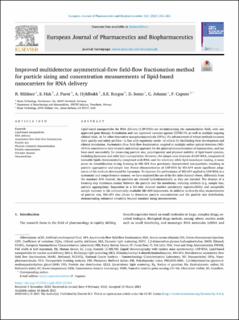| dc.contributor.author | Mildner, Robert | |
| dc.contributor.author | Hak, Sjoerd | |
| dc.contributor.author | Parot, Jeremie | |
| dc.contributor.author | Hyldbakk, Astrid | |
| dc.contributor.author | Borgos, Sven Even F. | |
| dc.contributor.author | some, dan | |
| dc.contributor.author | Johann, Cristoph | |
| dc.contributor.author | Caputo, Fanny | |
| dc.date.accessioned | 2022-09-20T06:48:54Z | |
| dc.date.available | 2022-09-20T06:48:54Z | |
| dc.date.created | 2021-08-29T22:28:58Z | |
| dc.date.issued | 2021 | |
| dc.identifier.citation | European journal of pharmaceutics and biopharmaceutics. 2021, 163 252-265. | en_US |
| dc.identifier.issn | 0939-6411 | |
| dc.identifier.uri | https://hdl.handle.net/11250/3019008 | |
| dc.description.abstract | Lipid-based nanoparticles for RNA delivery (LNP-RNA) are revolutionizing the nanomedicine field, with one approved gene therapy formulation and two approved vaccines against COVID-19, as well as multiple ongoing clinical trials. As for other innovative nanopharmaceuticals (NPhs), the advancement of robust methods to assess their quality and safety profiles—in line with regulatory needs—is critical for facilitating their development and clinical translation. Asymmetric-flow field-flow fractionation coupled to multiple online optical detectors (MD-AF4) is considered a very versatile and robust approach for the physical characterisation of nanocarriers, and has been used successfully for measuring particle size, polydispersity and physical stability of lipid-based systems, including liposomes and solid lipid nanoparticles. However, the unique core structure of LNP-RNA, composed of ionizable lipids electrostatically complexed with RNA, and the relatively labile lipid-monolayer coating, is more prone to destabilization during focusing in MD-AF4 than previously characterised nanoparticles, resulting in particle aggregation and sample loss. Hence characterisation of LNP-RNA by MD-AF4 needs significant adaptation of the methods developed for liposomes. To improve the performance of MD-AF4 applied to LNP-RNA in a systematic and comprehensive manner, we have explored the use of the frit-inlet channel where, differently from the standard AF4 channel, the particles are relaxed hydrodynamically as they are injected. The absence of a focusing step minimizes contact between the particle and the membrane, reducing artefacts (e.g. sample loss, particle aggregation). Separation in a frit-inlet channel enables satisfactory reproducibility and acceptable sample recovery in the commercially available MD-AF4 instruments. In addition to slice-by-slice measurements of particle size, MD-AF4 also allows to determine particle concentration and the particle size distribution, demonstrating enhanced versatility beyond standard sizing measurements. | en_US |
| dc.language.iso | eng | en_US |
| dc.publisher | Elsevier | en_US |
| dc.rights | Navngivelse 4.0 Internasjonal | * |
| dc.rights.uri | http://creativecommons.org/licenses/by/4.0/deed.no | * |
| dc.subject | Nanomedicine | en_US |
| dc.subject | Frit-inlet channel | en_US |
| dc.subject | Particle concentration | en_US |
| dc.subject | Physical–chemical characterisation | en_US |
| dc.subject | Particle size | en_US |
| dc.subject | Asymmetric-flow field-flow fractionation | en_US |
| dc.subject | RNA delivery | en_US |
| dc.subject | Lipid-based nanoparticles | en_US |
| dc.title | Improved multidetector asymmetrical-flow field-flow fractionation method for particle sizing and concentration measurements of lipid-based nanocarriers for RNA delivery | en_US |
| dc.type | Peer reviewed | en_US |
| dc.type | Journal article | en_US |
| dc.description.version | publishedVersion | en_US |
| dc.rights.holder | © 2021 The Author(s). Published by Elsevier B.V. | en_US |
| dc.source.pagenumber | 252-265 | en_US |
| dc.source.volume | 163 | en_US |
| dc.source.journal | European journal of pharmaceutics and biopharmaceutics | en_US |
| dc.identifier.doi | 10.1016/j.ejpb.2021.03.004 | |
| dc.identifier.cristin | 1929564 | |
| cristin.ispublished | true | |
| cristin.fulltext | original | |
| cristin.qualitycode | 2 | |

